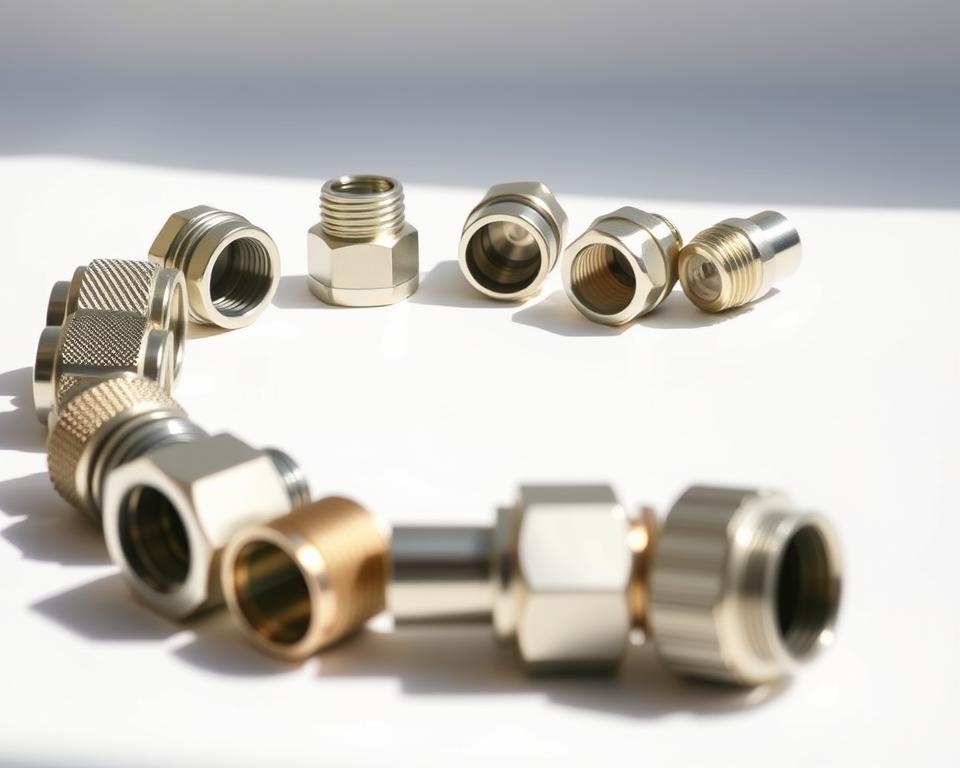Garden Hose Thread Size Chart Illustrated
Across America, the widely used garden hose thread measurement is ¾ inch (19mm). This measurement is vital for both domestic and industrial garden tasks. It’s critical to grasp the specifications of garden hose threads. Such action affects watering efficiency greatly. The American National Standards Institute (ANSI) has set the standard size at ¾”–11.5 NH (Garden Hose Thread – GHT). Possessing the accurate hose fitting size is basic. It prevents seepage and secures maximum water flow. For gardening tasks, the appropriate equipment is indispensable, and also the requirement to use a garden hose thread size chart. Understanding your plumbing thread sizes empowers homeowners to make knowledgeable and beneficial decisions for their garden’s requirements.
Important Takeaways
- The standard garden hose thread size is ¾ inch, commonly employed in multiple contexts.
- Accurately pairing hose and fitting sizes avoids leaks and boosts water distribution.
- Common domestic hose sizes include ½ inch, 5/8 inch, and ¾ inch.
- Grasping thread angle and diameter is essential for efficient hose connections.
- Routine inspection of connectors is advised for peak performance and upkeep.
Understanding Garden Hose Thread Basics
Grasping the fundamentals of garden hose threads is essential for improved gardening and watering effectiveness. These threads allow garden hoses to link to a variety of connectors and add-ons through a all-purpose system. Notably, the Garden Hose Thread (GHT) standard facilitates a stable connection between hoses, spigots, and watering gadgets. This alignment ensures a seamless fit within the more extensive watering setup, essential for matching connector sizes precisely.
Definition of Garden Hose Thread
Garden hose threads are tailored to guarantee a secure fit between hoses and their corresponding fittings, fostering widespread compatibility. The ¾ inch GHT is most commonly used, making it a standard size for many garden hoses. A thread size conversion table is extremely useful for choosing the suitable fittings for various needs. Being aware of various hose thread kinds, including those for specific hoses, simplifies the process of attaching accessories.
Importance of Thread Size in Water Flow
The girth of a garden hose’s thread greatly affects water circulation and its pressure. When thread sizes are accurately paired, the likelihood of dripping—at the risk of water pressure and efficiency—is diminished. Incorrect sizes can lead to suboptimal operation, stressing the need of uniform compatibility and routine inspections. Checking hose fittings for wear or failure is suggested, as such issues can hinder water flow.
Typical Garden Hose Thread Sizes
Grasping the different garden hose thread sizes is essential for the right fit and effective water circulation in your irrigation system. You’ll commonly see sizes such as ¾ inch, 5/8 inch, and ½ inch. A hose fitting size guide streamlines these differences, helping gardeners in their decisions. It guarantees that their selections meet their garden’s requirements optimally.
¾ Inch Garden Hose Thread
The ¾ inch garden hose thread is the chief choice for both domestic and business purposes. This size delivers ample water circulation, ideal for more expansive gardens and substantial irrigation demands. It’s engineered for easy hand-tightening, eliminating the necessity for tools. As per a size chart, over 95% of U.S. garden hoses follow this norm, showing its popularity.

5/8 Inch Garden Hose Thread
The 5/8 inch thread provides equilibrium between efficient watering and ease of use. It doesn’t provide the circulation of the ¾ inch, but it’s well-suited for limited spaces and individual plants. This size is notably useful and more compact, attractive to city dwellers with limited gardening zones. Knowing the different connector sizes assists in selecting the correct hose, enhancing watering efficiency.
½ Inch Garden Hose Thread
The ½ inch thread, albeit rarer, is critical for certain low-volume watering operations. It’s mostly found in lighter hoses and systems where a strong water jet isn’t needed. Selecting the correct hose fitting size mitigates problems like leaks and inefficiency. Frequent checks ensure that your hose connections are kept in excellent condition, reducing water waste.
Garden Hose Thread Size Guide
Understanding various garden hose thread sizes is essential for homeowners who need to connect hoses correctly. A garden hose thread size chart is an indispensable tool, detailing key sizes for easy visualization. It is imperative to use the suitable fittings. Incompatible sizes can lead to suboptimal water flow or harm.
Illustrated Summary of Standard Sizes
| Type of Thread | Designation | Compatibility | Usage |
|---|---|---|---|
| Garden Hose Thread | GHT | Uniform | Residential and business applications |
| National Pipe Thread | NPT | Tapered | Plumbing uses, elevated pressure setups |
| National Fire Hose Thread | NST | Full male/female compatibility | Fire suppression gear |
| National Pipe Straight Hose | NPSH | Multiple configurations | Hose coupling systems |
This table shows the standard thread sizes for garden hose fittings. The sizes mostly used are ¾ inch GHT and 5/8 inch GHT. These sizes align with the well-known hose measurements. Knowing these dimensions helps choose the correct products for effective garden care.
Concise Overview for Property Owners
- The ¾ inch size is the widely used. It connects with regular outdoor taps effectively.
- The 5/8 inch size is versatile for targeted tasks.
- ½ inch is perfect for compact, low-pressure jobs.
- It’s prudent to regularly inspect hose fittings to avert damage.
- A digital caliper secures accurate measurements for a ideal fit.
Determining Your Garden Hose Thread Size
Accurately measuring your garden hose thread size is essential for a ideal fit. Knowing how to measure your garden hose’s width ensures you pick the correct fittings for peak water circulation. This guide will assist you in determining correct sizes for smooth equipment integration.
Required Instruments for Exact Measurement
For accurate hose fittings and width measurements, you will need these tools:
- Digital calipers for exact inner and outer diameter readings.
- Tape measure for a general size approximation.
- Pen or notepad to jot down measurements.
- Ruler for further verification if necessary.
Sequential Instructions to Measuring
To measure your garden hose measurement, there are two primary steps: determining the inner diameter (ID) and the outer diameter (OD). Below are the guidelines for both assessments:
-
Measuring Inner Diameter:
- Extend the digital calipers sufficiently to enter the hose.
- Position the arms of the calipers into the hose and carefully bring together them until they touch the inner sides.
- Observe the displayed reading, which is the inner diameter.
-
Determining Outer Width:
- Place the calipers on the hose’s outer perimeter.
- Tune for a secure fit without over-tightening, which could deform the attachment.
- Record the outer diameter value from the calipers.
Once you have taken these measurements, consult a hose fitting size chart to find the suitable fittings. Correctly assessing your garden hose measurement not only secures compatibility with various nozzles but also preserves effective water pressure for your garden’s irrigation demands.
Different Types of Hose Threads
For anyone handling garden hoses, comprehending the various hose thread types is essential. These types are crafted for particular tasks, each with its unique purpose. Garden Hose Thread (GHT) and National Pipe Thread (NPT) are primarily used. Being aware of these helps prevent issues like leaks due to non-alignment.
Garden Hose Thread (GHT)
Within the USA, Garden Hose Thread (GHT) is the norm for garden hoses. It is noted for its non-tapered nature, ensuring it doesn’t constrict at the end. You’ll notice most garden hoses include a ¾ inch GHT fitting. This secures compatibility with attachments such as sprinklers and nozzles. GHT’s design focuses on ease of joining and disconnection, significantly reducing leaks and guaranteeing a stable fit.
National Pipe Thread (NPT) and Its Differences
Alternatively, National Pipe Thread (NPT) boasts a tapered design, rendering it a staple in plumbing. Its tapered form produces a tighter seal, suited for managing high pressure. Importantly, there are particular compatibility rules, such as female NPT fittings not matching with male NPSM or NPSH types. For those moving from garden hoses to more rigid plumbing setups, comprehending these differences is essential.
| Category of Thread | Designation | Fit | Purpose |
|---|---|---|---|
| Garden Hose Thread | GHT | Uniform | Home and commercial applications |
| National Pipe Thread | NPT | Gradually narrowed | Plumbing applications, elevated pressure setups |
| National Fire Hose Thread | NST | Complete gender-matched compatibility | Firefighting equipment |
| National Pipe Straight Hose | NPSH | Diverse pairings | Hose linkage setups |
Couplers and Fittings for Garden Hoses
Comprehending the types of threaded connectors and their roles is crucial in handling garden hoses efficiently. The correct adapters secure a snug fit and ease the transition between various sizes or types of threads. Employing the correct garden hose thread adapters enhances your watering system’s performance.
Varieties of Fitting Connectors
Different threaded connectors are pivotal for garden hoses:
- Constricting Connectors: Essential for linking hoses of varying widths, smoothing a smooth change from a larger to a compact hose.
- Enlarging Connectors: They are ideal for connecting smaller hoses to larger devices.
- Rapid Couplers: Facilitate swift and simple hook-up and release of hoses, making the watering process streamlined.
- Storz Connectors: Their unique design permits connections at various angles, primarily employed in firefighting gear.
Appropriate Situations for Adapters
Using garden hose thread adapters is advised in multiple situations:
- To join hoses of different diameters, one needs reducing or expanding adapters.
- If fittings don’t match due to threading issues, the correct adapter can guarantee a proper fit.
- It’s crucial to check connections regularly and exchange old fittings with appropriate adapters to avoid leaks and preserve water flow.
- For simpler seasonal hose detachment, quick-connectors considerably streamline the process.
In Summary
For garden lovers, understanding garden hose thread sizes is vital. A garden hose thread size chart simplifies the selection of necessary hoses and fittings. The ¾-inch garden hose thread, being the norm, ensures ample water circulation and pressure for most gardening tasks. On the other hand, 5/8-inch and 1/2-inch fittings are designed for specific, perhaps lighter watering needs.
Additionally, utilizing the proper adapters and connectors is essential for a stable, leak-free connection that provides maximum performance. Consistent care and monitoring of hose fittings are critical for their longevity, averting leaks that can suppress the gardening spirit. It’s also crucial for homeowners to select fittings made of materials most appropriate for their garden’s environment. Whether it’s durable brass, lightweight plastic, or stainless steel that offers anti-corrosive properties, the right material makes all the difference.
Installation Parts Supply is prepared to supply homeowners with a detailed hose fitting size guide. This assists in making knowledgeable decisions for their gardens. By focusing on accurate connections, gardeners can enhance their watering efficiency. Consequently, they’re able to truly relish their gardening activities.
FAQ
What’s the standard garden hose thread size?
As established by the American National Standards Institute (ANSI), the standard thread size for garden hoses is ¾”–11.5 NH (National Hose).
How do I measure my garden hose thread size?
Use a digital caliper or tape measure to determine the inner and outer measurements of your hose and its fittings.
Can you list the different sizes of garden hose threads?
Garden hose threads come in three main sizes: ¾ inch, 5/8 inch, and ½ inch. The ¾ inch size is the most widely used in homes and businesses.
What is the significance to use the correct thread size?
Choosing the right thread size is essential for fitting compatibility. It avoids leaks and maintains water flow and intensity optimally.
Identify the key thread types used in garden hoses?
Garden hoses primarily utilize two thread types: the non-tapered Garden Hose Thread (GHT) and the conical National Pipe Thread (NPT). GHT is typically for garden hoses, whereas NPT is often found in plumbing settings.
Which kinds of garden hose adapters and connectors are available?
There are several adapter and connector options, including those that reduce or upsize size and fast-connect fittings. These implements permit connections between different hose sizes and thread types.
How do I avoid leaks when attaching my garden hose?
To avoid leaks, begin by selecting the correct thread size and using compatible adapters. Ensure all connections are firmly fastened for a secure fit.
What is the metric equivalent for garden hoses?
Metric thread sizes are also offered for hoses and can be aligned using a conversion table for precise fittings.


